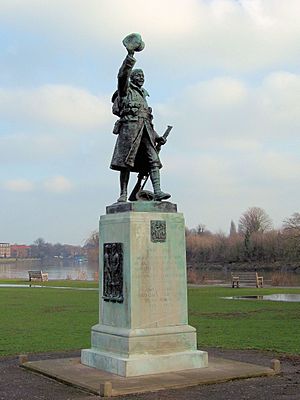Twickenham War Memorial facts for kids
Quick facts for kids Twickenham War Memorial |
|
|---|---|
| United Kingdom | |
 |
|
| For men from the district of Twickenham who died in the First and Second World Wars | |
| Unveiled | 1921 |
| Location | 51°26′25″N 0°19′54″W / 51.4402°N 0.3317°W Twickenham, Richmond upon Thames, London
|
| Designed by | Mortimer Brown |
|
1914–1918 TO THE GLORIOUS MEMORY OF THE MEN OF TWICKENHAM WHO FELL IN THE GREAT WAR THEIR NAME LIVETH EVERMORE AND TO THOSE WHO GAVE THEIR LIVES IN THE WAR OF 1939–1945
|
|
|
Listed Building – Grade II
|
|
| Official name | Twickenham War Memorial |
| Designated | 5 June 2017 |
| Reference no. | 1445040 |
The Twickenham War Memorial is a special statue in Radnor Gardens, Twickenham, London. It remembers the brave men from the Twickenham area who lost their lives in the First World War. After 1945, the memorial was updated to also honor those who died in the Second World War. The local council, called Twickenham Urban District Council, asked for this memorial to be built in 1921. It was designed by a sculptor named Mortimer Brown. This memorial is quite unique because it shows a happy soldier coming home. In 2017, it became a Grade II* listed structure, which means it's a very important historical building.
Contents
About the Memorial's Location
The Twickenham War Memorial stands in Radnor Gardens. This park was created in 1903. It used to be the private gardens of two large houses, Radnor House and Cross Deep House. The area around Richmond has always been a popular spot. Many wealthy Londoners built their country homes here long ago.
History and Design
After the First World War ended, many towns decided to build memorials. These memorials would remember the people from their area who had died in the war. Twickenham Urban District Council also decided to build one. They held a competition to choose the best design.
The Sculptor and His Work
The sculptor Mortimer Brown won the design competition in 1920. He was then asked to create the memorial. Brown had studied art at several famous schools. These included the Hanley School of Art and the Royal Academy Schools.
The memorial features a life-size soldier. This soldier is made of bronze. The bronze was cast by a company called Singer & Sons. The statue shows the soldier walking in his uniform and a long coat. He holds a rifle in one hand. With his other hand, he lifts his cap to wave it in the air.
This statue is special because it shows a "joyful returning soldier." Most war memorials show soldiers who are watchful or sad. The Twickenham memorial is different. It shows happiness and hope. Other memorials, like the Cambridge War Memorial, also show a cheerful soldier. Another older example is the Lancashire Fusiliers Boer War Memorial in Bury, Greater Manchester.
The Base and Plaques
The main soldier statue stands on a tall, square base. This base is made of Portland stone. There are bronze plaques on all four sides of the base. The south side has a special message. This message was updated after the Second World War. It now honors those who died in both wars.
Three of the bronze plaques have pictures carved into them.
- The west side shows three airmen.
- The north side shows two women. One is a nurse, and the other is a volunteer from the Voluntary Aid Detachment. It was "uncommon" to show women's contributions on memorials.
- The east side shows two naval officers and a sailor. This naval plaque was stolen in 2011. A new one was put in its place in 2012.
The borough's coat of arms is on a small bronze plaque. It is on the south side of the base, above the main message. The full message reads: 1914–1918 TO THE GLORIOUS MEMORY OF THE MEN OF TWICKENHAM WHO FELL IN THE GREAT WAR THEIR NAME LIVETH EVERMORE AND TO THOSE WHO GAVE THEIR LIVES IN THE WAR OF 1939–1945
Unveiling and Recognition
The memorial was placed so it would face the Star and Garter Home. This home was for soldiers who were injured. It was located on Richmond Hill.
The memorial was officially revealed on November 2, 1921. Field Marshal Sir William Robertson, 1st Baronet unveiled it. A band from the Royal Military School of Music played music. A large crowd came to watch, even though it was raining. On April 5, 2017, the memorial was given a Grade II* listed structure status. This means it is a very important historical monument.

